Jvc MX-K6 User Manual
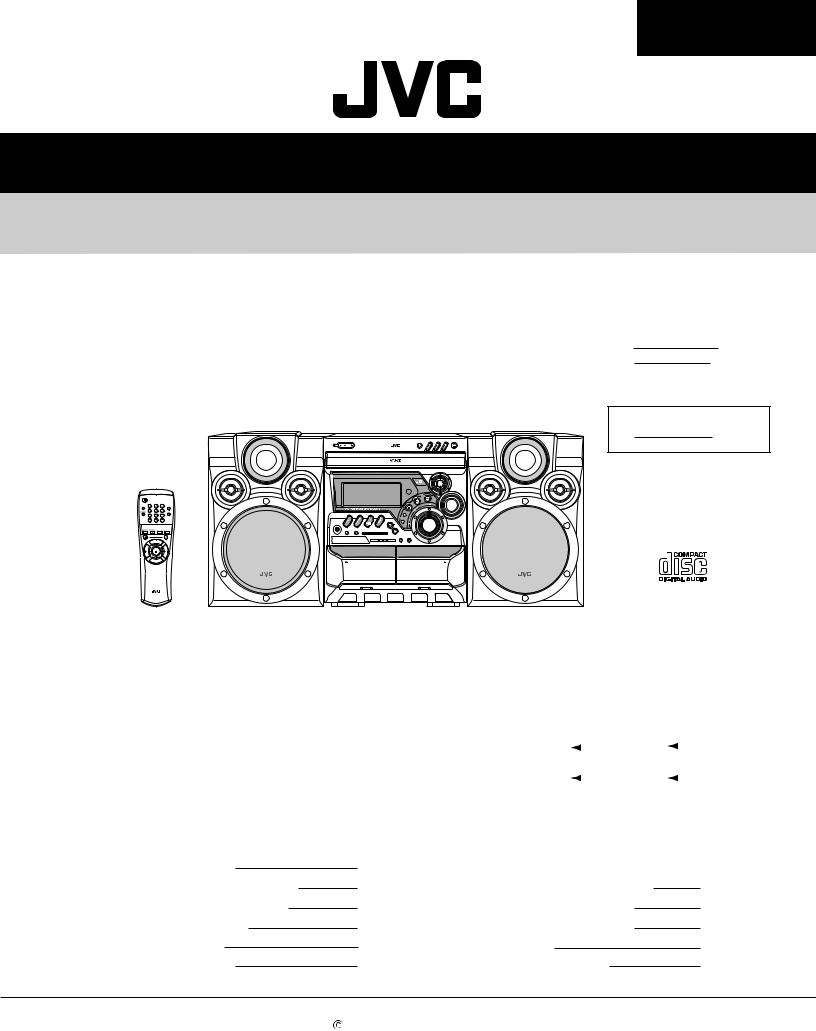
MX-K5/MX-K6
SERVICE MANUAL
COMPACT COMPONENT SYSTEM
MX-K5 / MX-K6 |
|
MX-K5 |
J |
U.S.A. |
|
|
|
Area Suffix |
|
C |
Canada |
|
|
|
|
|
MX-K6 |
|
|
|
|
|
|
DISC CHANGE |
|
|
|
|
|
|
CD-R/RW PLAYBACK |
|
|
COMPACT COMPONENT SYSTEM MX-K5 |
|
SOUND |
||
|
|
|
MODE |
|||
|
|
|
|
|
|
ACTIVE BASS |
|
|
|
|
|
|
EX. LEVEL |
|
|
|
|
|
|
PRESET |
1 |
2 |
3 |
|
|
|
|
4 |
5 |
6 |
|
|
|
|
|
|
|
|
|
SET |
|
7 |
8 |
9 |
|
|
|
|
|
|
|
|
|
CANCEL |
|
10 |
+10 |
|
|
|
/DEMO |
|
|
|
|
|
|
||
|
|
PHONES |
|
|
|
|
|
|
|
|
TUNING |
|
|
|
|
CLOCK |
|
|
|
|
|
|
/TIMER DISPLAY |
REPEAT PROGRAM |
RANDOM |
|
|
|
|
|
REC START CD |
TAPE A |
TAPE B |
|
|
|
ACTIVE BASS EXTENSION |
/STOP |
REC START DUBBING |
||
|
+ |
C O M P U P L AY C O N T R O L |
|
|
|
|
Area Suffix
C |
Canada |
– |
EJECT |
|
EJECT |
|
A PLAY |
FULL - LOGIC CONTROL |
CD SYNCHRO RECORDING REC/PLAY B |
SP-MXK5 CA-MXK5 SP-MXK5
Each difference points
MODEL |
CD/DECK/ |
Speaker |
|
Color |
|
|
|
|||
POWER / SUB / CD EJECT / |
|
VOLUME RING |
|
|
|
|||||
RECEIVER |
|
CD fitting |
||||||||
|
|
|
||||||||
|
|
|
DISK CHANGER bottom |
|
ornament |
|
|
|
||
MX-K5 |
CA-MXK5 |
SP-MXK5 |
SILVER |
|
|
|
|
|
|
|
|
|
|
|
|
|
|
||||
|
|
|
|
|
|
|
|
|
|
|
MX-K6 |
CA-MXK6 |
SP-MXK6 |
METALLIC LIGHT GRAY |
|
|
|
|
|
|
|
|
|
|
|
|
|
|
||||
|
|
|
|
|
|
|
|
|
|
|
Contents
Safety Precautions |
1-2 |
Important for laser products |
1-3 |
Preventing static electricity |
1-4 |
Disassembly method |
1-5 |
Wiring connection |
1-19 |
Adjustment method |
1-20 |
Flow of functional operating |
|
until TOC read |
1-24 |
Maintenance of laser pickup |
1-25 |
Replacement of laser pickup |
1-25 |
Trouble shooting |
1-26 |
Description of major ICs |
1-29 |
No.20928
COPYRIGHT 2001 VICTOR COMPANY OF JAPAN, LTD. |
Mar. 2001 |
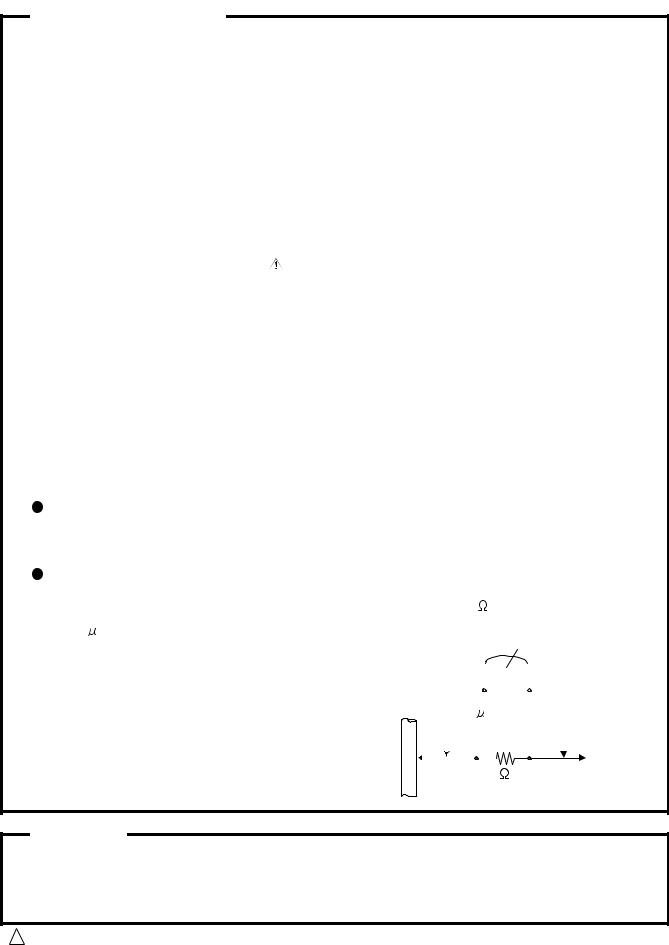
MX-K5/MX-K6
Safety Precautions
1. This design of this product contains special hardware and many circuits and components specially for safety purposes. For continued protection, no changes should be made to the original design unless authorized in writing by the manufacturer. Replacement parts must be identical to those
used in the original circuits. |
Services |
should be performed by qualified personnel only. |
||
2. Alterations of the design or |
circuitry |
of |
the product should not be made. |
Any design alterations of |
the product should not be made. |
Any |
design alterations or additions will |
void the manufacturer`s |
|
warranty and will further relieve the manufacture of responsibility for personal injury or property
damage resulting therefrom. |
|
|
3. Many |
electrical and mechanical parts in the products |
have special safety-related characteristics. |
These |
characteristics are often not evident from visual |
inspection nor can the protection afforded |
by them necessarily be obtained by using replacement components rated for higher voltage, wattage, etc. Replacement parts which have these special safety characteristics are identified in the Parts List of Service Manual. Electrical components having such features are identified by shading on the schematics and by ( ) on the Parts List in the Service Manual. The use of a substitute replacement which does not have the same safety characteristics as the recommended replacement parts shown in the Parts List of Service Manual may create shock, fire, or other hazards.
4. The |
leads |
in the products are routed and dressed with ties, clamps, tubings, barriers and the |
like |
to be |
separated from live parts, high temperature parts, moving parts and/or sharp edges |
for the prevention |
of electric |
shock and fire hazard. When service is required, the original lead |
||||
routing and dress |
should be |
observed, |
and it should be confirmed |
that |
they |
have been returned |
to normal, after re-assembling. |
|
|
|
|
||
5. Leakage currnet check (Electrical shock hazard testing) |
|
|
|
|||
After re-assembling the product, always |
perform an isolation check |
on |
the |
exposed metal parts |
||
of the product (antenna terminals, knobs, metal cabinet, screw heads, headphone jack, control
shafts, etc.) to be sure the product is safe to operate without danger |
|
of |
electrical shock. |
|||||||||||||||||||||||
Do not use a line isolation transformer during this check. |
|
|
|
|
|
|
|
|
|
|
|
|
|
|
||||||||||||
Plug |
the AC line cord directly into the AC |
outlet. |
Using |
a "Leakage |
Current |
Tester", measure |
||||||||||||||||||||
the |
leakage |
current from each |
exposed |
metal parts of |
the |
cabinet , particularly any exposed |
||||||||||||||||||||
metal part having a return path to the chassis, to a known |
good |
earth ground. Any leakage |
||||||||||||||||||||||||
current must not exceed 0.5mA AC (r.m.s.) |
|
|
|
|
|
|
|
|
|
|
|
|
|
|
|
|
||||||||||
Alternate |
check method |
|
|
|
|
|
|
|
|
|
|
|
|
|
|
|
|
|
|
|
|
|
||||
Plug |
|
the AC line cord directly into the AC |
outlet. |
Use |
an |
AC voltmeter having, 1,000 ohms |
||||||||||||||||||||
per |
volt or more sensitivity in |
the |
following manner. Connect a |
1,500 |
|
10W resistor paralleled by |
||||||||||||||||||||
a 0.15 |
F AC-type |
capacitor |
between an |
exposed |
|
|
|
|
|
|
|
|
|
|
|
|
|
|
|
|||||||
metal part and a known good earth ground. |
|
|
|
|
|
|
|
|
|
|
|
|
|
|
|
AC VOLTMETER |
||||||||||
|
|
|
|
|
|
|
|
|
|
|
|
|
|
|
||||||||||||
Measure the |
AC voltage across the resistor |
with the |
|
|
|
|
|
|
|
|
|
|
|
|
|
(Having 1000 |
||||||||||
AC voltmeter. |
|
|
|
|
|
|
|
|
|
|
|
|
|
|
|
|
|
|
|
|
|
ohms/volts, |
||||
|
|
|
|
|
|
|
|
|
|
|
|
|
|
|
|
|
|
|
|
|
||||||
Move |
the |
resistor |
connection |
to each |
exposed |
|
|
|
|
|
|
|
|
|
|
|
|
|
or more sensitivity) |
|||||||
|
|
|
|
|
|
|
|
|
|
|
|
|
|
|
||||||||||||
metal |
part, |
particularly |
any |
exposed |
metal part |
|
|
|
|
|
|
|
|
|
|
|
|
|
|
|
||||||
|
|
|
|
0.15 |
|
|
F AC TYPE |
|
||||||||||||||||||
having a return path to the |
chassis, and meausre |
|
|
|
|
|
|
|
||||||||||||||||||
|
|
|
|
|
|
|
|
|
|
|
|
|
|
|
||||||||||||
the |
AC voltage across |
the |
resistor. Now, reverse |
|
|
|
|
|
|
|
|
|
|
|
|
|
|
Place this |
||||||||
|
|
|
|
|
|
|
|
|
|
|
|
|
|
|||||||||||||
|
|
|
|
|
|
|
|
|
|
|
|
|
|
|||||||||||||
the plug in the AC outlet and repeat each |
|
|
|
|
|
|
|
|
|
|
|
|
|
|
probe on |
|||||||||||
|
|
|
|
|
|
|
|
|
|
|
|
|
|
|||||||||||||
measurement. voltage |
measured |
any |
must |
not |
|
|
|
1500 |
|
10W |
|
each exposed |
||||||||||||||
exceed 0.75 V AC |
(r.m.s.). This corresponds to 0.5 |
|
|
|
|
|
metal part. |
|||||||||||||||||||
|
|
|
|
|
|
|
|
|
|
|
|
|
|
|
||||||||||||
mA |
AC (r.m.s.). |
|
|
|
|
|
|
|
Good earth ground |
|
|
|
|
|
|
|
|
|
||||||||
|
|
|
|
|
|
|
|
|
|
|
|
|
|
|
|
|
|
|
|
|
||||||
Warning
1. This equipment has been designed and manufactured to meet international safety standards.
2. It |
is |
the |
legal responsibility of the repairer to ensure that these safety standards are maintained. |
|
3. Repairs |
must be made in accordance with the relevant safety standards. |
|||
4. It |
is |
essential that safety |
critical components are replaced by approved parts. |
|
5. If |
mains |
voltage selector |
is provided, check setting for local voltage. |
|
! CAUTION Burrs formed during molding may be left over on some parts of the chassis. Therefore, pay attention to such burrs in the case of preforming repair of this system.
1-2
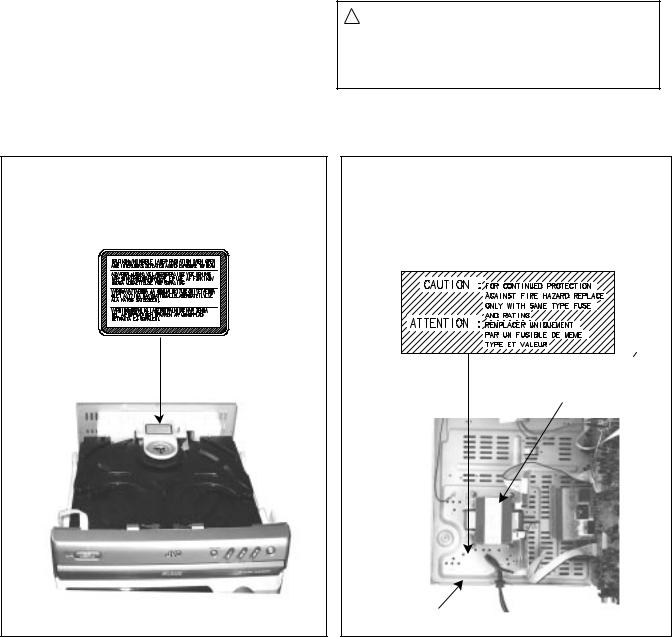
MX-K5/MX-K6
Important for laser products
1.CLASS 1 LASER PRODUCT
2.DANGER : Invisible laser radiation when open and inter lock failed or defeated. Avoid direct exposure to beam.
3.CAUTION : There are no serviceable parts inside the Laser Unit. Do not disassemble the Laser Unit. Replace the complete Laser Unit if it malfunctions.
4.CAUTION : The compact disc player uses invisible laserradiation and is equipped with safety switches whichprevent emission of radiation when the drawer is open and the safety interlocks have failed or are de feated. It is dangerous to defeat the safety switches.
5.CAUTION : If safety switches malfunction, the laser is able
to function.
6.CAUTION : Use of controls, adjustments or performance of procedures other than those specified herein may result in hazardous radiation exposure.
! CAUTION Please use enough caution not to see the beam directly or touch it
in case of an adjustment or operation check.
REPRODUCTION AND POSITION OF LABELS
WARNING LABEL
FUSE CAUTION
FUSE CAUTION LABEL
Power transformer
Bottom shassis

MX-K5/MX-K6
Preventing static electricity
1. Grounding to prevent damage by static electricity
Electrostatic discharge (ESD), which occurs when static electricity stored in the body, fabric, etc. is discharged, can destroy the laser diode in the traverse unit (optical pickup). Take care to prevent this when performing repairs.
2. About the earth processing for the destruction prevention by static electricity
In the equipment which uses optical pick-up (laser diode), optical pick-up is destroyed by the static electricity of the work environment.
Be careful to use proper grounding in the area where repairs are being performed.
2-1 Ground the workbench
Ground the workbench by laying conductive material (such as a conductive sheet) or an iron plate over it before placing the traverse unit (optical pickup) on it.
2-2 Ground yourself
Use an anti-static wrist strap to release any static electricity built up in your body.
(caption)
Anti-static wrist strap
Conductive material (conductive sheet) or iron plate
3. Handling the optical pickup
1. In order to maintain quality during transport and before installation, both sides of the laser diode on the replacement optical pickup are shorted. After replacement, return the shorted parts to their original condition. (Refer to the text.)
2.Do not use a tester to check the condition of the laser diode in the optical pickup. The tester's internal power source can easily destroy the laser diode.
4. Handling the traverse unit (optical pickup)
1.Do not subject the traverse unit (optical pickup) to strong shocks, as it is a sensitive, complex unit.
2.Cut off the shorted part of the flexible cable using nippers, etc. after replacing the optical pickup. For specific details, refer to the replacement procedure in the text. Remove the anti-static pin when replacing the traverse unit. Be careful not to take too long a time when attaching it to the connector.
3.Handle the flexible cable carefully as it may break when subjected to strong force.
4.It is not possible to adjust the semi-fixed resistor that adjusts the laser power. Do not turn it
Attention when CD mechanism assembly is decomposed
*Please refer to "Disassembly method" in the text for pick-up and how to detach the CD mechanism assembly.
1.Remove the CD changer unit.
2.Remove the CD changer mechanism.
3.Solder is put up before the card wire is removed from the pickup unit connector on the CD mechanism assembly.
(When the card wire is removed without putting up solder, the CD pick-up assembly might destroy.)
4.Please remove solder after connecting the card wire with the pickup unit connector when you install picking up in the substrate.
Card wire
Picup unit connector
Soldering 
CD changer unit
CD changer mechanism
Fig.1
Card wire
Picup unit connector
Fig.2
1-4
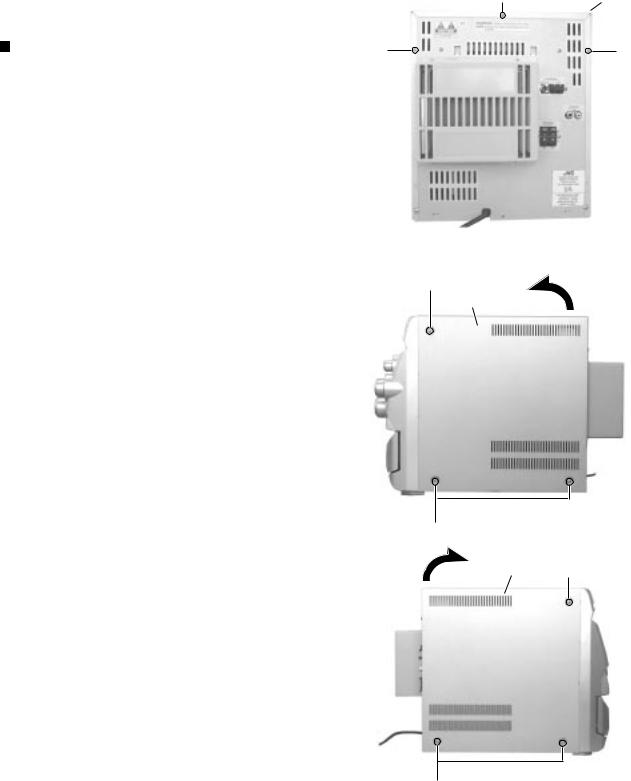
|
|
|
MX-K5/MX-K6 |
Disassembly method |
|
A |
Metal cover |
<Main body> |
|
|
|
Removing the metal cover |
A |
|
A |
(See Fig.1 to 3) |
|
|
|
1.Remove the three screws A attaching the metal cover on the back of the body.
2.Remove the six screws B attaching the metal cover on both sides of the body.
3.Remove the metal cover from the body by lifting the rear part of the cover.
ATTENTION: Do not break the front panel tab fitted |
Fig.1 |
|
to the metal cover. |
||
|
B
Metal cover
B Fig.2
Metal cover B
B Fig.3

MX-K5/MX-K6
 Removing the CD Tray fitting (1)
Removing the CD Tray fitting (1)
(See Fig. 4 to 6)
Prior to performing the following procedure, remove POWER button the metal cover.
1.Press the POWER button. Press the OPEN/CLOSE button to eject the CD tray.
2.After drawing the lower part of the tray fitting toward the front, remove the five claws a. Then, while moving the tray fitting upward, remove it.
3.Press the OPEN/CLOSE button to insert the tray.
CD tray fitting
 Removing the CD Tray fitting (2)
Removing the CD Tray fitting (2)
(See Fig. 5 to 7)
- How to eject the CD tray without turning on power -
1.Turn the black loading pulley gear marked b from the back of the CD changer unit as shown in Fig.7 and draw the CD tray toward the front.
2. |
After drawing the lower part of the tray fitting toward |
Claw a |
|
the front, remove the five claws a. Then, while |
|
|
moving the tray fitting upward, remove it. |
|
3. |
Push and insert the CD tray manually. |
|
(See Fig. 24)
CD tray
This slot of the board.
b
(Loading pulley gear)
CD tray
OPEN/CLOSE button
Fig.4
Joint
Fig.5
Fig.7 |
Fig.6 |
1-6

 Removing the CD changer unit
Removing the CD changer unit
(See Fig.8 to 10)
Prior to performing the following procedure, remove the metal cover.
1.Disconnect the card wire which is attached with adhesive to the left side of the CD changer unit.
2.Disconnect the card wire from connector CW105 of the CD servo board on the back of the CD changer unit.
3.Disconnect the harness from connector RCW6 on the inner side of the main board in the body.
Remove the two screws C attaching the CD changer
4.unit on the back of the body.
Remove the two screws D attaching the CD changer
5.unit on the both side of the body.
Draw the CD changer unit upward from behind while
6.pulling the rear panel outward.
Adhesive card wire strap
CD changer unit
D D
Rear panel
Fig.10 b
MX-K5/MX-K6
CD servo board
CW105 CD changer unit
Main board |
RCW6 |
|
Fig.8
C
Rear panel
Fig.9
CD changer unit
Rear panel
Fig.10 a
Front panel assembly

MX-K5/MX-K6
 Removing the front panel assembly
Removing the front panel assembly
(See Fig.11 to 13)
Prior to performing the following procedure, remove the metal cover and the CD changer unit.
1.Disconnect the card wire from connector FCW3 and the harness from connector JCW1, JCW2 and HCW3 on the inner side of the main board in the body.
2.Remove the two screws E attaching the front panel assembly on both sides of the body.
3.Remove the screw F attaching the earth terminal extending from the cassette mechanism assembly.
4.Remove the screw G attaching the front panel assembly and main board.
5.Remove the screw H attaching the front panel assembly on the bottom of the body.
6.Release the two joints c on both sides and two joints d on the bottom of the body using a screwdriver.
Front panel assembly
FCW3 |
Main board |
JCW2 |
|
JCW1 |
|
ACW1
ACW2
Joint c
E |
F |
HCW3 |
earth wire |
|
|
|
Fig.11 |
|
Front panel assembly
Main board
G
|
|
|
Joint c |
|
|
|
|
|
|
E |
|
|
Fig.12 |
|
|
Joint d |
H |
|
Joint d |
Bottom side
Fig.13
1-8

 Removing the heat sink & AMP board (See Fig.14 and 15)
Removing the heat sink & AMP board (See Fig.14 and 15)
Prior to performing the following procedure, remove the metal cover and the CD changer unit.
1.Remove the four screws I attaching the heat sink cover on the back of the body. Remove the heat sink cover.
2.Remove the four screws J attaching the heat sink & AMP board to the rear panel on the back of the body.
3.Remove the two screws K attaching the speaker terminal to the rear panel on the back of the body.
4.Disconnect the card wire from connector ACW1 & the harness from connector ACW2 on the AMP board. (See Fig.11)
5.After moving the heat sink upward, remove the claws. Then pull out the heat sink & AMP board
 Removing the tuner pack
Removing the tuner pack
(See Fig.15 and 16)
Prior to performing the following procedure, remove the metal cover and CD changer unit.
1.Disconnect the card wire from connector CON01 on the tuner board.
2.Remove the two screws L attaching the tuner pack.
 Removing the rear cover
Removing the rear cover
(See Fig.17)
Prior to performing the following procedure, remove the metal cover, CD changer unit, heat sink & AMP board and tuner pack.
1. Remove the four screws M attaching the rear panel.
M
M
MX-K5/MX-K6
I
Heat sink cover
I
Rear panel
Fig.14 |
Tuner terminal |
J
L
Heat sink



 K J
K J
Speaker terminal
Fig.15
Main board
CON01
Tuner board
Fig.16
Fig.17

MX-K5/MX-K6
 Removing the main Board
Removing the main Board
(See Fig. 18)
Prior to performing the following procedure, remove the metal cover, CD changer unit.
1.Disconnect the card wire from connector FCW3 and the harness from connector JCW1, JCW2 and HCW3 on the main board.
2.Disconnect the harness from connector PCW1 on the power transformer board.
3.Remove the screw G attaching the main board holder. (See Fig.12)
4.Remove the two screws N attaching the heat sink and bottom chassis.
 Removing the power IC
Removing the power IC
(See Fig.19 and 20)
Prior to performing the following procedure, remove the metal cover CD changer unit and heat sink & AMP board.
1.Remove the two screws P attaching the power IC to the heat sink.
2.Unsolder the power IC solder point.
 Removing the power transformer
Removing the power transformer
(See Fig .21)
Prior to performing the following procedure, remove the metal cover, heat sink & AMP board, tuner pack and rear cover.
1.Disconnect the power cord from connector RCW2 of the power transformer board.
2.Disconnect the harness from connector PCW1 of the power transformer board.
3.Remove the four screws R attaching the power transformer and the screw S attaching the earth.
FCW3 JCW2 JCW1 HCW3
Main board
PCW1
N
Transformer board
Fig.18
P
Heat sink
Fig.19 |
AMP board |
|
Power ICs solder point
Heat sink
Fig.20
Power transformer
PCW1
RCW2
R |
R S |
Power cord |
Fig.21 |
1-10

<Front panel assembly>
Prior to performing the following procedure, remove the metal cover, the CD changer unit and the front panel assembly.
 Removing the power / CD switch board (See Fig.22)
Removing the power / CD switch board (See Fig.22)
1.Disconnect the card wire from connector UCW1 on the power / CD switch board.
2.Remove the five screws T attaching the power / CD switch board and release the tab e.
MX-K5/MX-K6
Power / CD switch board |
UCW1 |
|
T |
|
Tab e |
|
U |
UCW2 |
FLdiplay & system |
UCW3 |
control board |
UCW4 |
U |
|
|
|
UCW5 |
|
UCW6 |
Fig.22
 Removing the FL display & system control board
Removing the FL display & system control board
(See Fig.22 and 23)
1.Disconnect the card wire from the connector UCW3, UCW4,UCW5 and UCW6 on the FL & system control board.
2.Remove the five screws U attaching the FL & system board.
3.Disconnect the card wire from the connector UCW2 on the FL & system control board.
Sound mode knob
Subwoofer knob
Volume knob
Fig.23
 Removing the headphone board
Removing the headphone board
(See Fig.24)
 Prior to performing the following procedure remove the FLdisplay & system control board.
Prior to performing the following procedure remove the FLdisplay & system control board.
1. You can pull out the headphone board.
 Removing the front board (See Fig.24)
Removing the front board (See Fig.24)
Prior to performing the following procedure, remove the FLdisplay & system control board.
1.Pull out the VOLUME knob, ACTIVE BASS EX. LEVEL knob and SOUND MODE nob from front
side.
2.
Remove the ten screws V attaching the front board and release the two tabs f out ward.
 Removing the cassette mechanism assembly (See Fig.24)
Removing the cassette mechanism assembly (See Fig.24)
1.Disconnect the card wire x from the mechanism board on the cassette mechanism assembly.
2.Remove the six screws W attaching the cassette mechanism assembly.
|
V |
Front board |
Headphone |
|
|
|
board |
f
V

 V
V
W
Card wire x
Cassette mechanism assembly
Fig.24
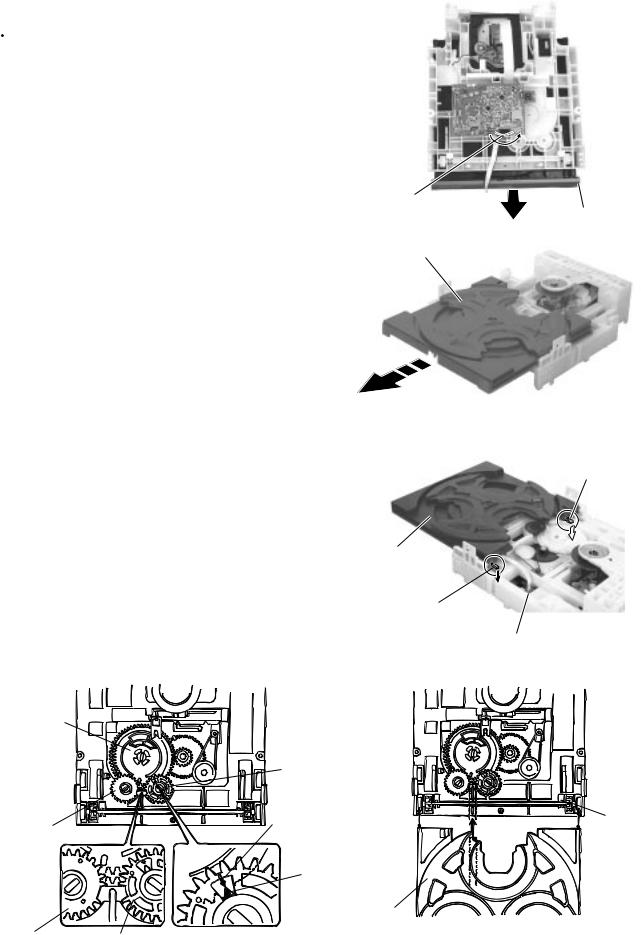
MX-K5/MX-K6
<CD changer unit>
Prior to performing the following procedure, remove the CD changer unit.
 Removing the CD tray (See Fig.25 to 27)
Removing the CD tray (See Fig.25 to 27)
1.Turn the black loading pulley gear on the under side of the CD changer unit in the direction of the arrow and draw the CD tray toward the front until it stops.
2.Disconnect the card wire from connector CW103 of the CD servo board on the upper side of the CD changer unit.
3.Push down the two tray stoppers marked g and pull out the CD tray.
 Reinstall the CD tray (See Fig.28 to 29)
Reinstall the CD tray (See Fig.28 to 29)
1.Align the gear-cam with the gear-tray as shown fig.27, then mount the CD tray.
2.When assembling the CD tray, take extreme care not engage with gear - synchro.
Gear-cam
Gear-tray
Loading pulley gear
CD tray
Fig.25
CD tray
Fig.26
g (Tray stopper)
CD tray
g (Tray stopper)
CD servo board CW103
Fig.27
Gear-convert |
Gear-cam |
Gear-synchro |
timing point |
|
|
|
Gear-tray |
|
|
|
CD tray |
Gear-convert |
Gear-tray |
Fig.29 |
|
Fig.28 |
1-12

 Removing the sensor board / the turn table motor assembly (See Fig.30 to 32)
Removing the sensor board / the turn table motor assembly (See Fig.30 to 32)
Prior to performing the following procedure, remove the CD tray.
1.Remove the screw X attaching the sensor board and release the two tabs h attaching the sensor board on the under side of the CD tray.
2.Disconnect the harness from connector CW1 on the sensor board and release the harness from the two
hooks i. Remove the sensor board. |
i |
|
3.Remove the screw Y attaching the turn table. Detach the turn table from the tray.
4.Pull outward the tab marked j attaching the turn table motor assembly on the upper side of the tray and detach the turn table motor assembly from the tray.
Tray
Turn table motor assembly
MX-K5/MX-K6
X
h
CW1
h
Sensor board
Fig.30
Turn table
Y
Fig.31
j
Fig.32
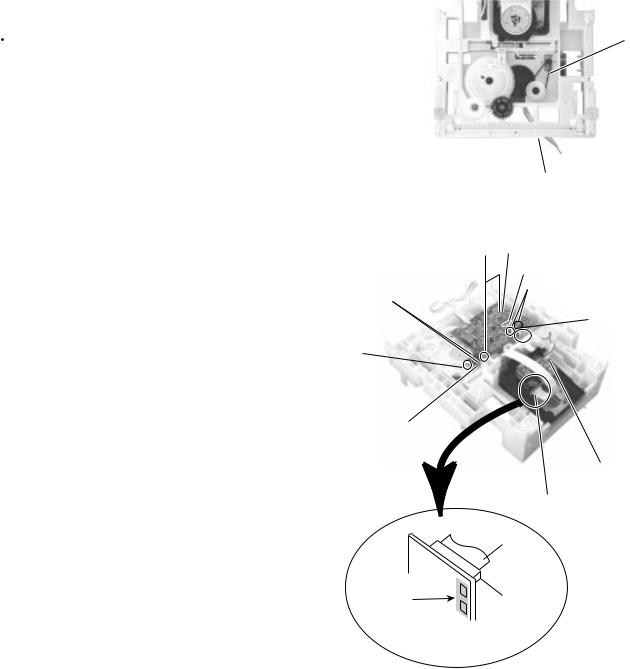
MX-K5/MX-K6
 Removing the belt, the CD servo board and the switch board (See Fig.33 and 34)
Removing the belt, the CD servo board and the switch board (See Fig.33 and 34)
Prior to performing the following procedure, remove the CD tray.
1.Detach the belt from the pulley on the upper side of the CD changer unit (Do not stain the belt with grease).
2.Disconnect the card wire from the pickup unit connector on the under side of the CD changer unit.
Attention : Solder is put up before the card wire is removed from the pick-up unit connector on the CD mechanism assembly.
(When the card wire is removed without putting up solder, the CD pick-up unit assembly might destroy.)
3.Disconnect the motor wire harness from connector on the CD servo board.
4.Remove the screw Z attaching the switch board and release the two tabs k attaching the switch board outward and detach the switch board.
5.Remove the two screws A' attaching the CD servo board and . First release the n side of the two tabs l and two tabs m attaching the CD servo board motor to raise the CD servo board slightly, then release the CD servo board.

 If the tabs l and m are hard to release, it is recommendable to unsolder the two soldered parts on the motor terminal of the CD servo board.
If the tabs l and m are hard to release, it is recommendable to unsolder the two soldered parts on the motor terminal of the CD servo board.
Belt
CD changer unit
Fig.33
A' CD servo board
Tabs m
Soldered parts
Tabs k

 Motor
Motor
 Tabs l
Tabs l
Z
Switch board
CW3
CD mechanism board motor connector
Pickup unit connector
Card wire
Soldering |
Pickup unit |
|
connector |
Fig.34
1-14

 Removing the CD mechanism holder assembly (mechanism included)
Removing the CD mechanism holder assembly (mechanism included)
(See Fig.35 to 38)
1.Disconnect the harness from connector on the CD mechanism board in the CD mechanism assembly on the under side of the CD changer unit. Disconnect the card wire from the pickup unit connector.
Attention : Solder is put up before the card wire is removed from the pick-up unit connector on the CD mechanism assembly. (Refer to Fig. 33)
(When the card wire is removed without putting up solder, the CD pick-up unit assembly might destroy.)
2.Remove the screw B' attaching the shaft on the right side of the CD mechanism holder assembly. Pull outward the stopper fixing the shaft on the left side and remove the CD mechanism holder assembly from behind in the direction of the arrow.
3.Turn the CD mechanism holder assembly half around the lift up slide shaft n of the CD mechanism holder assembly until the turn table is reversed, and pull out the CD mechanism holder assembly.
MX-K5/MX-K6
Motor connector
CD changer unit
CD mechanism holder assembly Pickup unit connector
Fig.35
B'
Stopper
CD mechanism holder assembly
Fig.36
Lift up slide shaft n
Lift up slide shaft
y
CD mechanism holder assembly |
CD mechanism holder assembly |
|
Fig.38 |
Fig.37 |

MX-K5/MX-K6
<CD mechanism section>
•Removing the CD mechanism holder from the CD chager unit.
(Refer to "Removing the CD mechanism holder assembly" )
 Removing the pickup unit. (See Fig.1)
Removing the pickup unit. (See Fig.1)
1.Removing the cut washer c on the feed gear sleeve and pull out the feed gear.
2.Remove the two screws A fixing the pickup shaft.
3.Removing the pickup unit.
 Removing the motor board. (See Fig.2)
Removing the motor board. (See Fig.2)
1.Unsolder the motor terminal on the motor board.
2.Remove the moter board.
 Removing the feed motor. (See Fig.1)
Removing the feed motor. (See Fig.1)
Remove the two motor fixing screws at B and removing the feed motor.
 Removing the spindle motor.
Removing the spindle motor.
The spindle motor cannot be removed as a single unit. When removing the spindle motor, change the chasis and turntable together as aunit.
A
Motor board
Spindle motor
Shutter |
Shaft |
Pickup unit |
|
A
|
|
|
|
Cut washer |
||
|
|
|
|
|||
|
|
|
|
|||
B |
||||||
|
|
Feed Gear |
||||
|
|
|
Fig.1 |
|||
|
|
|
|
|||
Unsolder Feed motor
Unsolder
Fig.2
1-16
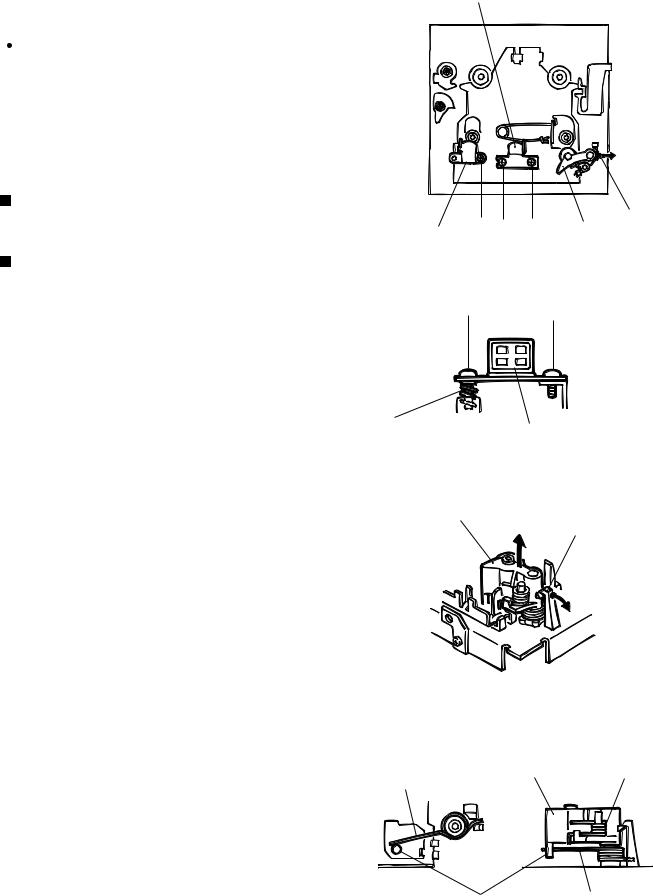
<Cassette mechanism section>
Removing the record/playback mechanism.
 Removing the R/P head.
Removing the R/P head.
1.Remove the screw A on the right side of the R/P head.(Fig.1, Fig.2)
2.Remove the screw B on the left side of the R/P head.(Fig.1, Fig.2)
Remove the erase head.
Remove the screw C fixing the erase head.(Fig.1)
Removing the pinch roller.
1.Pull out the pinch roller by opening the pinch roller stopper outward to unlock .(Fig.3)
2.When reassembling the pinch roller, refer to fig. 4 to hook up the spring.
MX-K5/MX-K6
R/P Head
|
|
Stoppsr |
E. Head |
C B |
A |
|
Pinch roller |
|
|
|
assembly |
Fig.1
B A
Spring |
R/P Head |
|
Fig.2 |
Pinch roller
Pinch roller stopper
Fig.3 |
|
Pinch roller |
Pinch roller |
spring |
Return spring
Return spring |
Return spring |
Fig.4

MX-K5/MX-K6
Removing the motor.
1.Remove the two screws D fixing the motor. Be careful to grease's splash when the drive belt comes off.(Fig.5, Fig.6)
2.Unsolder the motor terminal.(Fig.5)
Removing the mechanism board.
1.Unsolder the four parts a on the solenoid coil terminal.(Fig.5)
2.Remove the two screws E fixing the board.(Fig.5)
3.Unhook the three parts b from the board.(Fig.5)
4.Remove the mechanism board.(Fig.5)
|
Mecha. |
|
Motor |
|
|
|
|
terminal |
|
|
|
a |
board |
b |
|
|
|
|
E |
b |
|||
|
E |
|
D |
||
|
|
|
|
||
|
|
|
|
|
D |
a |
|
Drive belt |
||
Motor |
||
Fig.5 |
|
|
Drive belt (Flat) |
Motor |
|
|
Removing the flywheel.
Remove the cut-washers at c and d from the
capstan shaft, then remove the flywheel. When reassembling the flywheel,
be sure to use new washers as they
cannot be reused.(Fig.8, Fig.9)
Drive belt Fig.6
Capstan
washer
Fig.7
d
c
Sleeve
Sleeve
Washer
FR belt
Flywheel
FR belt Flywheel
Flywheel
Fig.9 |
Fig.8 |
Capstan
washer
1-18
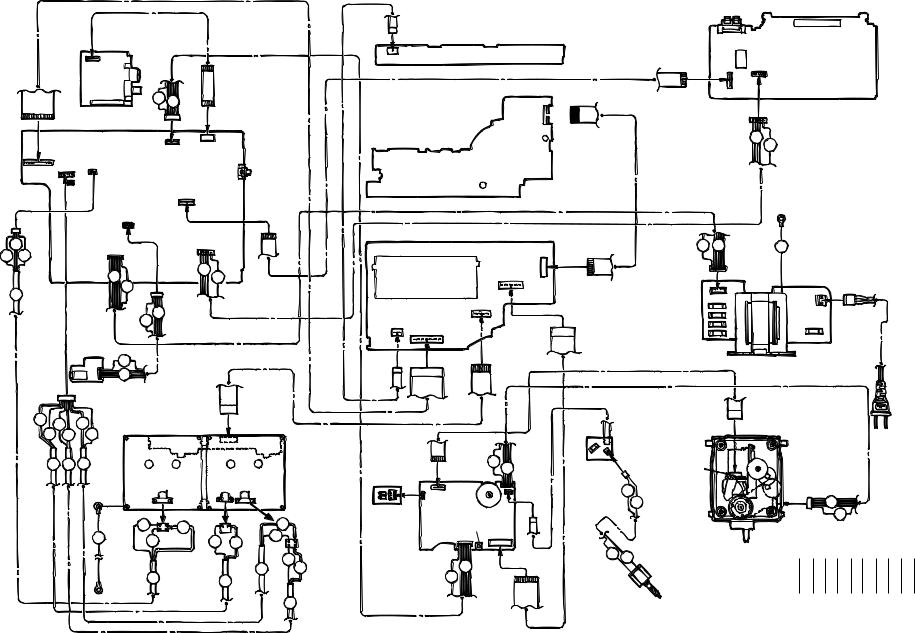
3708-000258
3708-000122
Tuner board
|
|
|
|
|
JW1 |
|
|
|
|
|
|
|
|
|
|
|
|
0 |
9 |
|
|
|
|
|
|
|
|
|
|
FCW1 |
|
|
|
FCW3 |
|
|
|
|
RCW6 |
|
|
||
|
|
|
|
|
|
|
|
|
||
|
|
JCW2 |
JCW1 |
|
|
|
|
|||
|
|
|
Main board |
|
|
|||||
|
|
|
|
|
|
|
|
|||
|
|
|
FCW3 |
|
|
FCW2 |
|
|
||
|
|
|
|
|
|
|
|
|
|
|
|
|
|
|
|
|
HCW3 |
|
|
|
|
0 |
2 |
|
|
|
|
RW1 |
|
RW2 |
|
|
9 |
|
|
|
|
|
|
|
|
||
|
|
|
|
|
|
|
|
|
||
|
|
|
|
|
|
9 |
|
9 |
|
|
|
|
|
|
|
|
|
0 |
|
|
|
0 |
|
|
|
|
|
0 |
|
|
|
|
|
|
|
|
|
|
|
|
|
|
|
|
|
|
|
|
|
|
9 |
|
|
|
|
|
00022A- |
|
|
|
|
0 |
|
|
|
|
|
|
|
|
9 |
|
|
|
|
|
|
|
|
|
|
HCW2 |
|
|
|
|
|
|
|
|
|
|
|
0 |
|
|
|
|
|
|
AH39 |
|
|
|
|
AH39-00247A |
|
|
|
|
|
|
E.phone J.board |
|
|
|
||||
|
|
|
|
|
|
|
||||
|
0 |
9 |
|
|
0 |
Cassette mechanism |
|
|
||
|
|
|
|
|
|
|||||
|
|
9 |
0 |
|
9 |
|
|
|||
|
|
|
|
|
|
|
|
|||
AH39-20002D |
|
8 |
8 |
|
2 |
|
|
|
|
|
|
|
|
|
|
|
2 |
|
|
0 |
|
|
|
|
|
|
|
|
0 |
|
||
|
|
|
|
|
0 |
|
9 |
9 |
0 |
9 |
|
|
|
|
|
|
|
||||
|
|
|
|
|
|
|
|
|
2 |
9 |
|
|
|
|
|
|
|
2 |
|
0 |
|
|
|
|
|
|
|
|
|
8 |
|
|
|
|
|
|
|
|
|
|
|
|
|
|
|
|
|
|
|
|
|
|
|
8 |
3809-001228
UCW1 CD key switch board
3809-001224
UCW7 

Front key switch board
AH39-00254A
AH39-00249A
Front / Display board |
UCW2 |
UCW3 |
|
UCW4 |
|
UCW5
UCW6
ACW2
Amp board
ACW1
9
0
0 |
9 |
0 |
|
|
Power transformer |
PCW1 |
|
RCW2 |
RFS5 |
|
|
RFS6 |
|
RFS2 |
RFS7 |
|
|
RFS8 |
|
|
connection Wiring
|
|
|
|
|
3809-001121 |
|
|
|
|
|
|
|
|
AH39-20561P |
|
|
|
3809-001185 |
|
610 |
|
|
|
CD mechanism |
|
|
|
|
- |
|
|
|
|
|
|
|
|
502 |
|
CW2 |
|
|
||
|
|
|
|
|
|
|||
|
0 9 |
- |
|
|
|
AAN1 |
|
|
|
16634 |
CW3 |
CW1 |
|
|
|||
|
|
|
|
|
|
|||
|
|
|
|
|
|
|
||
CW3 |
|
CW102 |
|
|
2 |
|
|
|
CW101 |
|
CW103 |
|
|
9 |
|
|
|
|
|
|
0 |
Color |
|
|||
CW104 |
|
|
|
|
|
|||
|
|
|
|
|
|
0 |
|
|
CW107 |
|
|
2 |
0 |
1 2 3 4 5 6 7 8 9 0 |
codes |
|
|
CW106 |
CW105 |
|
|
|
||||
9 |
|
|
001034-3809 |
|
|
Brown Red Orange Yellow Green Blue Violet Gray White Black |
.belowshownare |
K5/MX-MX |
0 |
|
|
|
|
||||
|
|
|
|
|
|
|
|
|
AH39-20025S |
|
|
|
|
|
|
|
|
|
|
|
|
|
|
|
|
K6- |

MX-K5/MX-K6
Adjustment method
1. Tuner
* Adjustment Location of Tuner PCB
|
AM(MW) OSC |
AM(MW) RF |
|
LW OSC |
|
AM(MW) RF |
||||||||
ITEAM |
Adjustment |
Adjustment |
|
Adjustment |
|
Adjustment |
||||||||
|
|
|
|
|
|
|
|
(Except for J/C) |
|
|
|
|
||
|
|
|
|
|
|
|
|
|
|
|
|
|
|
|
Received FREQ. |
530~1710 KHz |
594 KHz |
|
146~290 KHz |
|
|
150 KHz |
|||||||
|
|
|
|
|
|
|
|
|
|
|
|
|
|
|
Adjustment |
MO |
|
MA |
|
|
|
LO |
|
|
|
LA |
|||
point |
|
|
|
|
|
|
|
|
|
|
|
|
|
|
|
|
|
|
|
|
|
|
|
|
|
|
|
|
|
Output |
1~7.0 0.5V |
Maximum |
|
|
|
2~7.0 0.5V |
|
Maximum |
||||||
|
|
|
|
Output(Fig1-4) |
||||||||||
|
|
|
Output(Fig1-4) |
|
|
|
|
|
||||||
|
|
|
|
|
|
|
|
|
|
|
|
|
|
|
|
|
MAIN |
VT |
GND |
|
|
|
TESTER |
|
|
|
|||
|
|
PCB |
|
|
|
|
|
|
|
|
|
|
|
|
|
|
|
|
|
|
|
|
|
|
|
|
|
|
|
|
|
|
|
|
|
|
|
|
|
|
|
|
|
|
|
|
|
|
|
|
|
|
|
|
|
|
|
|
|
|
|
|
|
|
|
|
|
|
|
|
|
|
|
|
|
|
|
|
|
|
|
|
|
|
|
|
|
|
|
Fig 1-4 OSC Voltage
1-20

FM THD Adjustment
SSG FREQ. |
98 MHz |
Adjustment
point FM DETECTOR COIL (FM DET)
Output |
60 dB |
Minumum Distortion (0.4% below) (Figure 1-1)
|
|
|
MX-K5/MX-K6 |
Output |
FM |
|
|
Antenna |
SET |
|
|
GND |
|
||
Terminal |
|
|
|
|
|
|
|
FM S.S.G |
|
Input |
Oscilloscope |
|
|
||
|
Speaker |
|
|
|
Terminal |
output |
Input |
|
|
||
|
|
Distortion Meter |
|
Figure1-1 IF CENTER and THD Adjustment
FM Search Level Adjustment
SSG FREQ. |
98 MHz |
|
|
|
|
Adjustment |
BEACON |
|
point |
|
|
SENSITIVITY |
|
|
(SVR1) |
SEMI-VR(20K |
) |
|
|
|
Output |
28 dB( 2dB) |
|
|
|
|
Adjust SVR1 so that "TUNED" of |
FL T |
|
is lighted (Figure 1-2) |
|
|
*Adjust FM S.S.G level to 28dB
AM(MW) I.F Adjustment
SSG FREQ. |
450 kHz |
|
|
Frequency |
522 kHz |
|
|
Adjustment |
AM IF |
point |
|
|
|
Maximum output (Figure 1-3)
|
28 dB |
FM Antenna |
|
|
SET |
FM S.S.G |
GND |
FM IN |
|
20 k
Figure1-2 FM Auto Search Level Adjustment
60cm |
|
|
|
AM IF |
|
OUTPUT |
AM ANT |
|
IN |
||
|
||
AM SSG |
Speaker Terminal |
|
450KHZ |
|
|
INPUT |
OUTPUT |
|
VTVM |
Oscilloscope |
Figure1-3 AM I.F Adjustment
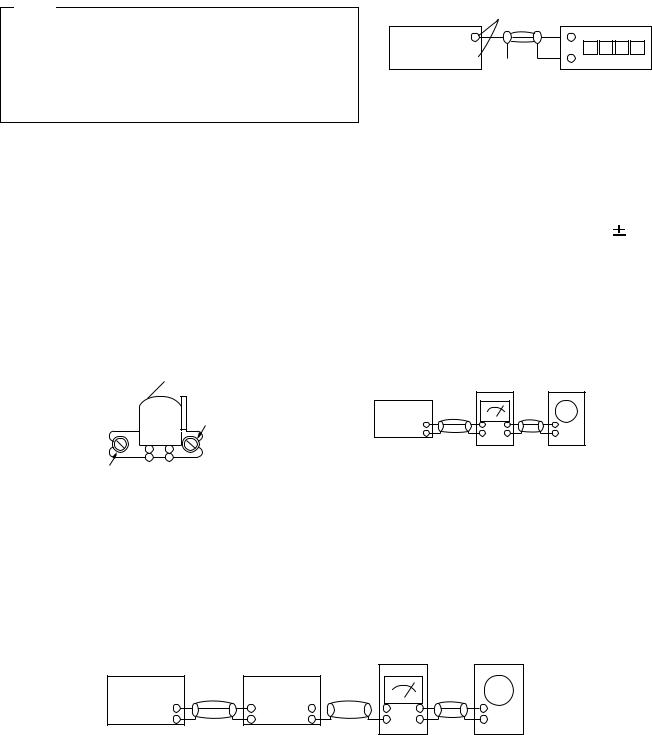
MX-K5/MX-K6
2 Cassette Deck
To adjust tape speed
Notes
1) Measuring tape: i) VT-712/MTT-111(or equivalent) (Tapes recorded with 3kHz)
ii)AC-225/MTT-5512(or equivalent)
2)Connect the cassette deck to the frequency counter as in figure 1-5.
Cassette Deck |
Frequency Counter |
SPK OUT 
output
Figure 1-5
Step |
|
Item |
|
Pre-Setup |
|
|
Pre-Setup |
|
To Adjust |
Standard |
Remark |
||||||||
|
|
Condition |
|
|
|
||||||||||||||
|
|
|
|
|
|
|
|
|
|
|
|
|
|
|
|
|
|
||
|
|
|
|
|
|
|
|
|
|
|
|
|
|
|
|
|
|
|
|
|
|
|
|
|
|
|
|
|
|
|
|
|
|
|
|
|
|
|
|
|
|
|
|
|
|
|
|
|
1) |
Deck 1:VT-712 |
|
|
|
|
|
|
|
||
|
|
|
|
|
|
|
OUT |
|
|
|
|
|
|
|
|
||||
|
|
|
|
|
|
|
|
|
|
|
|
|
|
|
|
|
|
|
|
|
|
|
|
NOR |
|
|
2) |
Press PLAY |
|
|
|
|
|
|
|
1% |
|||
|
1 |
|
|
|
|
|
|
|
|
|
|
|
|
|
|
||||
|
|
|
|
|
(connected |
|
|
Turn VSR1 to |
|
|
|
|
|||||||
|
|
|
|
SPEED |
|
|
|
|
|
SW button |
|
|
|
|
3KHz |
|
range |
||
|
|
|
|
|
|
|
|
|
|
||||||||||
|
|
|
|
|
|
to the frequency |
|
|
|
|
|
left and right |
|
|
|
||||
|
|
|
|
Control |
|
|
|
|
|
|
|
|
|
|
|
|
|||
|
|
|
|
|
|
|
|
3) |
Deck 2:Same |
|
|
|
|
|
|
|
|||
|
|
|
|
|
|
|
|
|
|
(FRONT PCB) |
|
|
|
|
|
||||
|
|
|
|
|
|
|
counter) |
|
|
|
|
|
|
|
|
|
|||
|
|
|
|
|
|
|
|
|
|
|
|
||||||||
|
|
|
|
|
|
|
|
|
|
as above |
|
|
|
|
|
|
|
|
|
|
|
|
|
|
|
|
|
|
|
|
|
|
|
|
|
|
|
|
|
|
|
|
|
|
|
|
|
|
|
|
|
|
|
|
|
|
|
||
|
|
|
|
|
|
|
|
|
|
|
|
|
|
|
|
|
|
||
|
|
|
|
|
|
|
|
|
|
|
|
|
|
|
|
|
|
|
|
|
|
|
|
|
|
|
|
|
|
|
|
|
|
|
|
|
|
|
|
Recording /Play head |
|
Oscilloscope |
|
Cassette Deck |
VTVM |
||
|
|||
SPK OUT |
|
|
|
(GND) |
In Out |
|
|
|
|
||
AZIMUTH control screw |
Figure 1-7 |
|
|
Figure 1-6 |
|
|
SET |
|
VTVM |
Oscilloscope |
(MAIN PCB) |
|||
Audio OSC. |
|
|
|
LINE OUT |
|
|
|
IN |
TP |
|
|
AUX IN |
JCW3 |
IN OUT |
|
|
|
|
|
Figure 1-8
1-22
